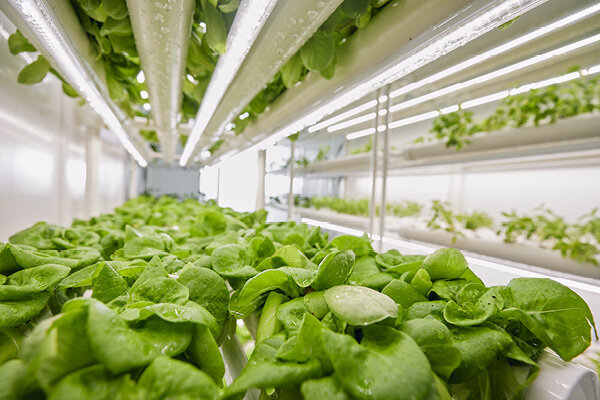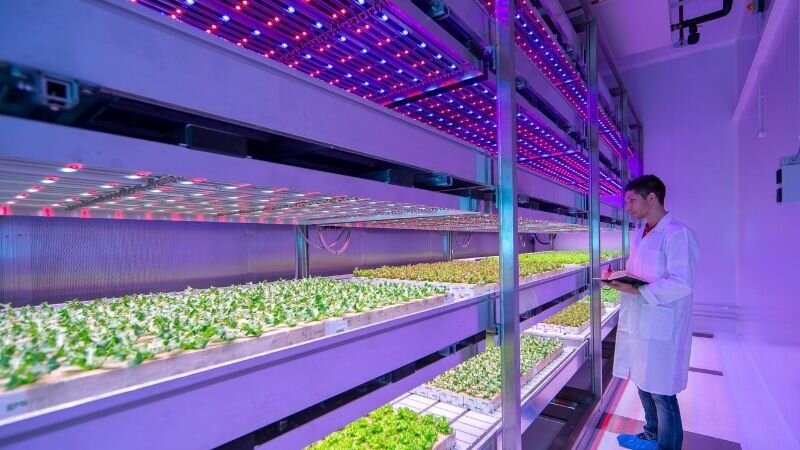Oct 6, 2021
9 Indoor Lighting Companies To Look Out For

Image sourced from BIOS Lighting
Editor’s Note: The following list details some of the many indoor grow light suppliers. As there are numerous suppliers around the world that specialize in horticultural lighting for indoor farms, this list is not exhaustive but rather meant to illustrate the variety of ways in which lighting suppliers are creatively meeting the needs of their customers.
When you see an indoor vertical farm, what do you notice first? Is it the abundance of leafy greens being grown, the space-saving racking systems that stack crops as high up as the ceiling, or the state-of-the-art technologies that ensure a strong yield?
For most, it’s likely the LED grow lights that glow all shades of pinkish-purple.
Traditional farming methods rely on natural sunlight to support plants through the process of photosynthesis. One of the challenges with this is the varying amount of sunlight throughout the year, or based on weather, that the plant will receive. And if plants receive too much or too little light, the following issues can occur:
They won’t produce chlorophyll
They’ll become leggy and have more gaps between the leaf nodes
They’ll drops their leaves
They’ll get scorched or bleached leaves

Today, with artificial lighting, we’re able to avoid these challenges entirely - making up for the lack of natural sunlight in cloudier climates or during low-light times of the year, while also preventing leaves from getting scorched during sunnier times. Horticultural lighting can now be set to follow precise light regimes to create the perfect growing conditions for our crops.
How Crops Respond To Light
We all know that plants need light for photosynthesis, but what most people don’t know is that plants perceive different wavelengths of light using distinct photoreceptors. For crop production, it is necessary to split the solar spectrum into three wavelength ranges (wavebands): Ultraviolet (UV), Photosynthetically Active Radiation (PAR), and Near Infrared (NIR).
Whilst PAR is the part of the radiation spectrum that plants use for photosynthesis, UV and NIR affect some crop development processes. Photosynthesis is dependent on the number of photons in the PAR range rather than the energy they carry.
The chemicals that control plant growth respond to red and blue light waves differently. Recent advancements in LED technology have enabled us to take advantage of this developmental plasticity of crops by manipulating lighting to enhance both crop yield and quality.
The grow lights market is also expected to grow tremendously. According to BusinessWire, the industry was valued at $2.71 billion in 2020 and is expected to reach $7.60 billion by 2026.
Here is Agritecture’s list of indoor lighting suppliers to look out for:
BIOS: The NASA spinoff providing LED lighting solutions for both humans & plants
A current Agritecture client, BIOS Lighting uses a “biology-first approach” to provide white spectrum technology that drives higher yields, per the company. With over 30 patents for their innovative lighting solutions, Sean Tegart, President and CEO of BIOS, shares that the versatile Icarus™ line is a game-changer for commercial growers. “We've included cleanable glass lenses to ensure maximum light output and uniformity. Also, Icarus is P66 wet rated to enable years of operation in harsh growing environments.”
Curious to learn more about the economics of LEDs as they relate to higher crop yields? Join Agritecture’s Founder & CEO, Henry Gordon-Smith, alongside other lighting experts, for our upcoming webinar: “The Future of Vertical Farming: Growing Smarter with LEDs”, sponsored by BIOS, on October 25th at 12 pm EDT.
SANlight: Creating autonomous vegetable farms in extreme environments

Image sourced from SANlight GmbH
Based in Austria, SANlight GmbH has been innovating lighting solutions for plant growth since 2011. The team shares that they’re “revolutionizing professional crop production with innovative lighting technology and tailor-made exposure solutions that guarantee efficient photosynthesis and biomass production.” Under the coordination of the Swiss Space Center, they are working with students, as part of the interdisciplinary IGLUNA platform, to develop a fully autonomous aeroponic system - GrowBotHub - that can grow vegetables in extreme environments like the moon.
GE Current: Winner of the Indoor AgCon ‘Best Overall Indoor Farm Light Fixture’
This company works to “power growth at an industrial scale” by creating lighting solutions for both greenhouses and indoor farms. GE Current’s new Lynk2 is ideally suited to propagation and tissue culture laboratories, due to the 0-10V dimming. With this new feature, growers are not limited to only selecting the best possible spectrum for their crops, they can also control the intensity of light delivered throughout the growth cycle, nurturing delicate seedlings through to established, mature plants, ready to harvest.

Image sourced from Kroptek LED
Kroptek LED Lights: Partnering with the National Plant Phenomics Centre
This former Agritecture client was founded as a research-driven LED grow lights company but recently expanded its activities to fully integrated commercial projects. Kroptek LED lights offer certified quality in even the harshest environments, with a 5-year warranty and the possibility to fully customize lighting systems, while also encouraging growers to trial solutions on their premises. They recently partnered with the National Plant Phenomics Centre in Wales to enable an energy-efficient transition allowing for over 50% savings in annual lighting costs.
Signify: Horticultural lighting for more sustainable food production

Image sourced from Signify N.V.
Signify N.V., formerly known as Philips Lighting N.V, began researching horticultural lighting in 2005 with the strong belief that “quality combined with sustainability will drive the success of horticultural lighting systems.” Their high-efficiency 3rd generation LEDs offer a linear solution to both greenhouse and vertical farm growers, alongside their Philips GrowWise Control System that allows growers to create custom ‘light recipes’ that give full control of the outcome of the crop’s quality. The team began their dedicated cannabis research in 2019, and now has production projects in the US, Portugal, and Macedonia.
Heliospectra: Lighting solutions that let you try-before-you-buy
This global leader is working with growers across the globe to provide lighting solutions for tomatoes, cannabis, cucumbers, peppers, leafy greens, and more. Through Heliospectra’s customized integrated light control systems, growers can forecast production, predict yield, and maximize growth all year round.
But Heliospectra doesn’t stop there. Their try-before-you-buy services offer you the chance to perform a pilot or R&D study to receive real production data and verify your ROI calculation. You can even use their lab to evaluate the best lighting strategy for your crops.

Image sourced from Fluence Engineering
Fluence by OSRAM: Winner of the 2021 Vertical Farming World Award for ‘Best Lighting Development’
This former Agritecture client has a “desire to bring innovation to the market; they were the first to introduce white light that mimics sunlight.” The team firmly believes that “light that does not reach your crop is wasted – wasted money, electricity and opportunity.” As a result, Fluence Engineering has designed lighting solutions for precise, uniform photon delivery, whatever the environment.
Valoya: Partnering with scientists and cultivators to add nutritional content to plants
As one of the early pioneers, this research-driven manufacturer advances the fields of photobiology and agriculture so as to improve the efficiency of food and medicine production for the growing global population. The Valoya team is also working to develop a method to add nutritional content to plants, as well as on pharmaceutical applications that might someday be used to combat disease and hunger.

Image sourced from Vertically Urban
Vertically Urban: NASA-inspired turnkey lighting solutions
With full spectrum LED grow lights, this company offers complete turnkey solutions. Andrew Littler, CEO of Vertically Urban, shares that they combine very low-profile fitting with “our proprietary extraction techniques and our control technologies. This methodology is inspired by the NASA space station where they have grown hydroponically for years. It has now come down to Earth. The difference is that it has reached the point where the return on investment is sound.”


